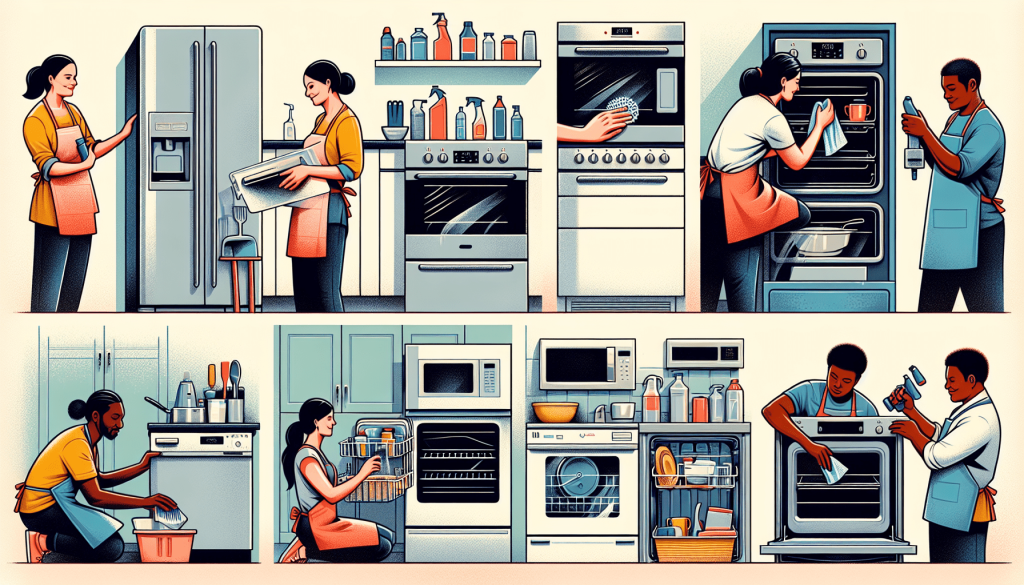Keeping your kitchen appliances clean and well-maintained is essential for a functional and hygienic cooking space. From your trusty oven to your reliable dishwasher, these appliances work hard to make your life easier. In this article, you will discover valuable tips and techniques on how to properly clean and maintain your kitchen appliances, ensuring their longevity and peak performance. Whether you’re a seasoned chef or a novice in the kitchen, these simple yet effective methods will help you keep your appliances running smoothly for years to come.

Refrigerator
Cleaning the interior
To keep your refrigerator clean and hygienic, it is important to regularly clean the interior. Start by removing all the food items from the fridge and storing them in a cooler. Then, take out all removable shelves and drawers and wash them with warm soapy water. Wipe down the interior walls and surfaces with a mixture of water and mild detergent, making sure to remove any spills or stains. Once cleaned, dry the shelves and drawers thoroughly before placing them back in the refrigerator.
Cleaning the exterior
The exterior of your refrigerator is prone to fingerprints, smudges, and food spills. To clean it, mix a small amount of mild detergent with warm water and use a soft cloth or sponge to wipe down the surface. Pay attention to the handles, as they often accumulate dirt and grime. For stainless steel refrigerators, use a stainless steel cleaner or polish to maintain their shine. Avoid using abrasive cleaners or scrub brushes, as they can damage the surface.
Defrosting
If you have a freezer compartment in your refrigerator, it is important to defrost it regularly to prevent ice buildup. Turn off the refrigerator and empty the freezer of all food items. Place towels or a large container to catch the melting ice, and leave the freezer door open to allow the ice to melt naturally. Avoid using sharp objects or heaters to speed up the defrosting process, as they can damage the freezer. Once defrosted, clean the interior as mentioned before, and remember to wipe away any excess water.
Cleaning the coils
The coils of your refrigerator play a crucial role in cooling the appliance, and it is important to keep them clean to ensure efficient operation. Start by unplugging the refrigerator and locating the coils, which are usually located at the back of the appliance or underneath. Use a coil brush or a soft brush attachment on your vacuum cleaner to gently remove any dust or debris. Avoid using water or liquid cleaners on the coils, as they can cause damage. Regularly cleaning the coils will help prolong the lifespan of your refrigerator and improve its energy efficiency.
Checking seals and gaskets
The seals and gaskets on your refrigerator door are essential for maintaining the temperature inside. To check if they are working properly, close the refrigerator door on a dollar bill or a sheet of paper. If you can easily pull out the paper, it may be time to replace the seals. To clean the seals and gaskets, wipe them down with a mild cleaning solution and a damp cloth. Make sure to remove any food particles or debris that may have accumulated on them. Keeping the seals and gaskets clean and in good condition will help prevent cold air leaks and maintain the freshness of your food.
Oven
Cleaning the oven interior
Cleaning the interior of your oven is an important task to remove grease, food residues, and burnt-on stains. Start by removing the oven racks and soaking them in warm soapy water. While the racks are soaking, prepare a paste using baking soda and water. Spread the paste on the interior walls and surfaces of the oven, avoiding the heating elements. Let it sit for several hours or overnight to loosen the grime. Then, using a damp cloth or sponge, scrub the surfaces to remove the paste and any dislodged debris. Rinse the cloth or sponge frequently and continue scrubbing until the interior is clean. Finally, rinse the oven racks, dry them thoroughly, and place them back in the oven.
Cleaning the oven racks
To clean the oven racks, start by filling your sink or a large container with warm soapy water. Place the oven racks in the water and let them soak for a few hours to loosen the grime. After soaking, use a scrub brush or sponge to scrub away any remaining debris or stains. Rinse the racks with clean water and dry them thoroughly before placing them back in the oven. Regularly cleaning the oven racks will prevent the buildup of grease and prolong their lifespan.
Cleaning the oven door
The oven door is often overlooked but requires regular cleaning to remove fingerprints, grease, and food splatters. Start by mixing warm water with a small amount of dish soap or mild detergent. Use a soft cloth or sponge to apply the soapy water to the oven door, paying extra attention to any spots or stains. Rinse the cloth or sponge and wring out excess water, then use it to wipe away the soapy residue. For stubborn stains, you can use a paste made of baking soda and water, applying it with a soft cloth and gently scrubbing the area. Finally, dry the door with a clean cloth to prevent streaks or watermarks.
Cleaning the control panel
The control panel of your oven can accumulate dirt, grease, and food particles over time. To clean it, start by turning off the oven to prevent any accidental activation. Use a soft cloth or sponge dampened with warm soapy water to wipe down the control panel. Pay attention to the buttons and knobs, ensuring that no liquid enters the openings or electrical components. Dry the control panel with a clean cloth to prevent any damage from moisture. Regularly cleaning the control panel will keep it looking good and prevent any malfunctions.
Removing burnt-on stains
Burnt-on stains in your oven can be stubborn and difficult to remove. Start by applying a mixture of baking soda and water to the stained areas, creating a thick paste. Let it sit for several hours or overnight to loosen the stains. Then, use a damp cloth or sponge to scrub the stained areas, applying gentle pressure. Rinse the cloth or sponge frequently and continue scrubbing until the stains are removed. For extremely stubborn stains, you can use a non-abrasive oven cleaner following the manufacturer’s instructions. Remember to thoroughly rinse the interior of the oven to remove any residual cleaning products before using it again.

Microwave
Wiping the interior
Cleaning the interior of your microwave is essential to remove food splatters, stains, and odors. Start by unplugging the microwave and removing any removable parts, such as the turntable or microwave-safe trays. Soak these parts in warm soapy water while you clean the interior. Using a mixture of water and mild dish soap, dampen a clean cloth or sponge and wipe down the interior walls, ceiling, and floor of the microwave. Pay extra attention to any stubborn stains or spots, gently scrubbing them with the cloth or sponge. Rinse the cloth or sponge frequently, and continue wiping until the interior is clean. Finally, dry the interior with a clean cloth or let it air dry before reassembling the microwave.
Cleaning the exterior
The exterior of your microwave is prone to fingerprints, food splatters, and general dirt. To clean it, mix a small amount of mild detergent with warm water and use a soft cloth or sponge to wipe down the surface. Pay particular attention to the control panel and buttons, ensuring that no liquid seeps into the electrical components. For stainless steel microwaves, use a stainless steel cleaner or polish to maintain their shine. Avoid using abrasive cleaners or scrub brushes, as they can damage the surface. Regularly cleaning the exterior of your microwave will keep it looking clean and presentable.
Removing stains and odors
Microwaves are often used to heat up food, which can lead to stains and lingering odors. To remove stains, dampen a cloth or sponge with a mixture of water and white vinegar or lemon juice, and scrub the stained areas. For stubborn stains, you can create a paste using baking soda and water and apply it to the stains, letting it sit for a few minutes before scrubbing. To remove odors, place a microwave-safe bowl filled with water and a few slices of lemon or a tablespoon of white vinegar inside the microwave. Heat the mixture for a few minutes until it starts steaming, then let it sit for a while before wiping down the interior. This will help eliminate any unpleasant odors and leave your microwave smelling fresh.
Cleaning the turntable
The turntable of your microwave is prone to food spills and stains. To clean it, remove it from the microwave and wash it with warm soapy water or place it in the dishwasher if it is dishwasher-safe. Use a cloth or sponge to scrub away any stubborn stains. Rinse the turntable thoroughly and let it dry before placing it back in the microwave. Regularly cleaning the turntable will prevent the buildup of food debris and ensure even heating of your food.
Caring for the door
The microwave door is constantly opened and closed, making it prone to dirt, fingerprints, and food splatters. To care for the door, wipe it down regularly with a damp cloth or sponge. Use a mild cleaning solution if necessary but avoid getting any liquid in the openings or electrical components. Dry the door with a clean cloth to prevent streaks or watermarks. Additionally, check the door seals periodically to ensure they are clean and not damaged. Clean door seals will prevent any heat or steam from escaping and keep your microwave running efficiently.
